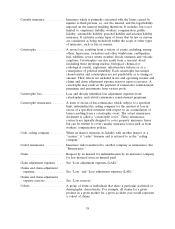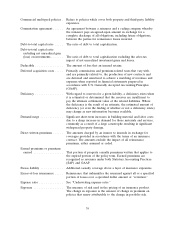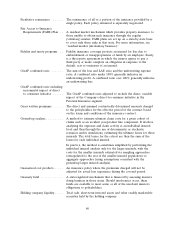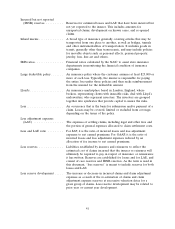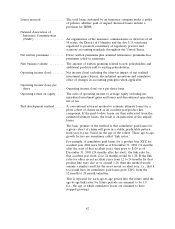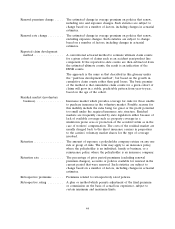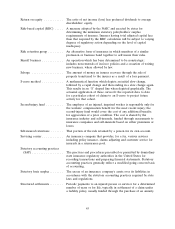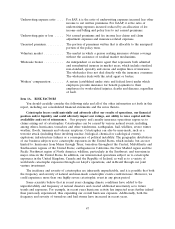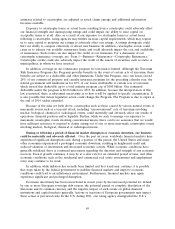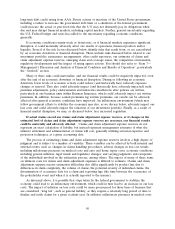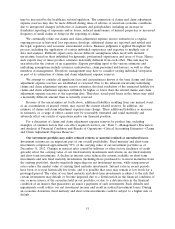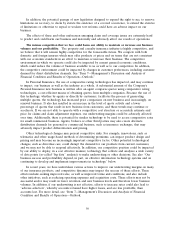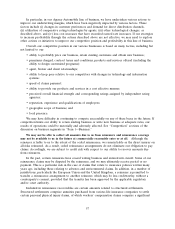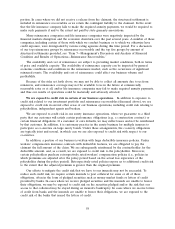Travelers 2012 Annual Report Download - page 60
Download and view the complete annual report
Please find page 60 of the 2012 Travelers annual report below. You can navigate through the pages in the report by either clicking on the pages listed below, or by using the keyword search tool below to find specific information within the annual report.All of the catastrophe modeling tools that we use, or that we rely on from outside parties, to help
manage certain of our catastrophe exposures are based on assumptions and judgments that are subject
to error and mis-estimation and may produce estimates that are materially different than actual results.
In addition, compared to models for hurricanes, models for earthquakes are less reliable due to there
being a more limited number of significant historical events to analyze, while models for tornadoes and
hail storms are newer and may be even less reliable due to the highly random geographic nature and
size of these events. As a result, models for earthquakes and especially for tornado and hail storms may
have even greater difficulty predicting risks and estimating losses. Further, changes in climate
conditions could cause our underlying modeling data to be less predictive, thus limiting our ability to
effectively evaluate and manage catastrophe risk. See ‘‘We may be adversely affected if our pricing and
capital models provide materially different indications than actual results’’ below as well as ‘‘Item 7—
Management’s Discussion and Analysis of Financial Condition and Results of Operations—Catastrophe
Modeling’’ and ‘‘—Changing Climate Conditions.’’
The extent of losses from a catastrophe is a function of both the total amount of insured exposure
in the area affected by the event and the severity of the event. Increases in the value and geographic
concentration of insured property and the effects of inflation could increase the severity of claims from
catastrophic events in the future. For example, the specific geographic location impacted by tornadoes
is inherently random and unpredictable and the specific location impacted by a tornado may or may
not be highly populated and may or may not have a high concentration of our insured exposures.
States have from time to time passed legislation, and regulators have taken action, that have the
effect of limiting the ability of insurers to manage catastrophe risk, such as legislation prohibiting
insurers from reducing exposures or withdrawing from catastrophe-prone areas or mandating that
insurers participate in residual markets. Participation in residual market mechanisms has resulted in,
and may continue to result in, significant losses or assessments to insurers, including us, and, in certain
states, those losses or assessments may not be commensurate with our direct catastrophe exposure in
those states. If our competitors leave those states having residual market mechanisms, remaining
insurers, including us, may be subject to significant increases in losses or assessments following a
catastrophe. In addition, following catastrophes, there are sometimes legislative and administrative
initiatives and court decisions that seek to expand insurance coverage for catastrophe claims beyond the
original intent of the policies or seek to prevent the application of deductibles. Also, our ability to
adjust terms, including deductible levels, or to increase pricing to the extent necessary to offset rising
costs of catastrophes, particularly in the Personal Insurance segment, requires approval of regulatory
authorities of certain states. Our ability or our willingness to manage our catastrophe exposure by
raising prices, modifying underwriting terms or reducing exposure to certain geographies may be limited
due to considerations of public policy, the evolving political environment, changes in the general
economic climate and/or social responsibilities. We also may choose to write business in catastrophe-
prone areas that we might not otherwise write for strategic purposes, such as improving our access to
other underwriting activities.
There are also factors that impact the estimation of ultimate costs for catastrophes. For example,
the estimation of claims and claim adjustment expense reserves related to hurricanes can be affected by
the inability to access portions of the impacted areas, the complexity of factors contributing to the
losses, the legal and regulatory uncertainties and the nature of the information available to establish
the claims and claim adjustment expense reserves. Complex factors include, but are not limited to:
determining whether damage was caused by flooding versus wind; evaluating general liability and
pollution exposures; estimating additional living expenses; the impact of demand surge; infrastructure
disruption; fraud; the effect of mold damage; business interruption costs; and reinsurance collectability.
In recent years, increased late reporting of weather-related losses by claimants, particularly losses from
hail damage, has led to higher costs than we previously expected. The timing of a catastrophe’s
occurrence, such as at or near the end of a reporting period, can also affect the information available
to us in estimating claims and claim adjustment expense reserves for that reporting period. The
48


